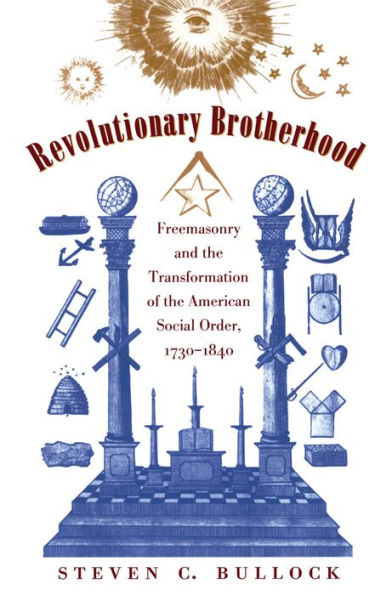Table of Contents
Contents
Acknowledgments
List of Illustration
List of Tables
Introduction: Understanding Salem Town's Fraternity
Part I: Colonial Masonry
1. Newton and Necromancy: The Creation of the Masonic Fraternity
I. The Remains of the Mysterys of the Ancients
II. The Augustan Style
III. An Honour Much Courted of Late
2. The Appearance of So Many Gentlemen: Masonry and Colonial Elites, 1730-1776
I. The United Party for Virtue
II. The Greatest Order and Regularity
III. A Very Harmless Sort of People
Part II: The Revolutionary Transformation
3. Where Is Honour? The Rise of Ancient Masonry, 1752-1792
I. The Good Old Way
II. The Mason's Arms
III. The Country People
4. According to Their Rank: Masonry and the Revolution, 1775-1792
I. Great Trubles amonge Masons
II. Free and Independent
III. The Cares and Fatigues of the Soldier's Life
Part III: Republican Masonry
5. A New Order for the Ages: Public Values, 1790-1826
I. Temples of Virtue
II. The Great Instrument of Civilization
III. Around the Enlightened World
6. An Appearance of Sanctity: Religion, 1790-1826
I. Neutral Ground
II. Dedicated to the Worship of God
III. Spiritual Masonry
IV. Cavils, Objections, and Calumnies
7. Preference in Many Particulars: Charity and Commerce, 1790-1826
I. The Most Charitable and Benevolent of the Human Race
II. Bound to Regard You as a Mason
8. In Almost Every Place Where Power is of Importance: Politics, 1790-1826
I. The Most Influential and Respectable men
II. We Have Nothing to Do with Politics
III. Men of All Parts of the Union Mingling Together
9. Into the Secret Place: Organization and Sacrilization, 1790-1826
I. The Lodge of Instruction
II. The Rugged Road
III. The Thick Veil
Part IV: Masonry and Democracy
10. The Lion and the Crows: Antimasonry, 1826-1840
I. The Concentration of Great Numbers on a Single Point
II. A Stupendous Mirror
III. These Desperate Fanatics
Epilogue: Losing the Right to Reverence: Masonry's Decline and Revival
A Note on Masonic Sources
Notes
Index
Illustrations
1. George Washington
2. Masonic Temple
3. The Temple of Solomon
4. The Five Points of Fellowship
5. Les Free Masons
6. The Second Grand Anniversary Procession
7. Lodge Summons, Philadelphia Ancient Lodge No. 2
8. Saint Peter's Lodge Night
9. Membership Certificate, Rising States Lodge
10. Prostyle Temple
11. Tracing Board
12. University of North Carolina Cornerstone
13. Freemason's Heart Supported by Justice and Liberty
14. Membership Certificate, Alexandria Lodge
15. Tavern Sign
16. Advertisement, J. T. Jacobs and Co.
17. The Master's Carpet
18. The Fifth Libation
19. The Chamber of Reflection
20. The Masonic Minstrel
21. The Living Arch Three times Three
22. The Living Arch
23. Masonic Penalties
24. Antimasonic Apron
25. Master Mason's Certificate
Tables
1. Occupations of Modern Masons, Boston, and St. John's Members, Philadelphia, 1750-1770
2. Occupations of Ancient Masons, St. Andrew's Lodge, Boston, and Lodge No. 2, Phladelphia, 1752-1775
3. Summary of Occupations of Ancient and Moderns
4. Boston Masons in 1771 Provincial Tax
5. Philadelphia Masons in 1756 City Tax
6. Occupations of Port Royal Lodge Members
7. Public Offices of Port Royal Lodge Members
8. Military Ranks of Members of Three Lodges
9. Military Ranks of Lodge No. 19 (Ancient), Pennsylvania Artillery
10. Occupations Listed in Lexington Kentucky, Directory, 1806, and of Lodge Members, 1794-1810
11. Age at Membership of Jordan Lodge Members, Danvers, Massachusetts, 1808-1827
12. Occupations of Members of Ark Lodge, Geneva, New York, and Jordan Lodge Members, Danvers, Massachusetts, 1807-1827
13. Occupations of St. Andrew's Lodge, Boston, and Lodge No. 2, Philadelphia, 1790-1820
14. Occupations of Members of Holland Lodge No. 9, New York City, 1787-1800
15. Public Offices Held by Ark Lodge Members, Geneva, New York, 1807-1819
16. Residential Distribution of Masons, 1794-1827
17. Occupations of Members of St. Andrew's Royal Arch Chapter, Boston, 1769-1823
18. Occupations of Philadelphia Masons, Harmony Chapter No. 52, and Knights Templars, Union Chapters Nos. 1 and 2, and St. John's Commandery No. 4, 1795-1831
19. Occupations in Geneva, New York, Higher-Degree Bodies, 1812-1819
20. New Members, St. Andrew's Lodge, Boston, 1822-1843
21. Lodges Represented at New York Grand Lodge Annual Communications, 1827-1840



